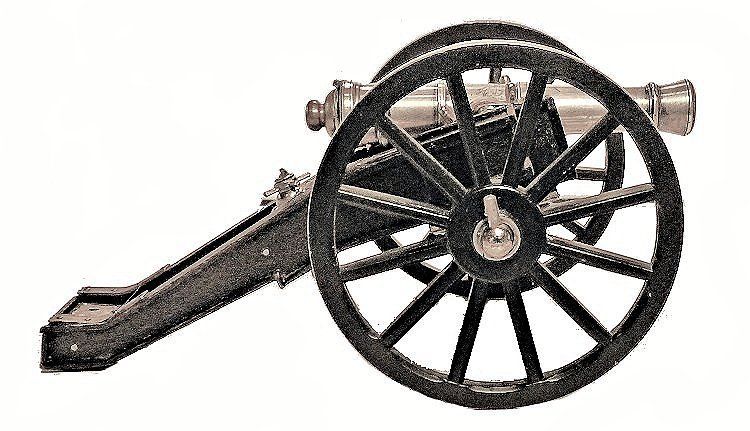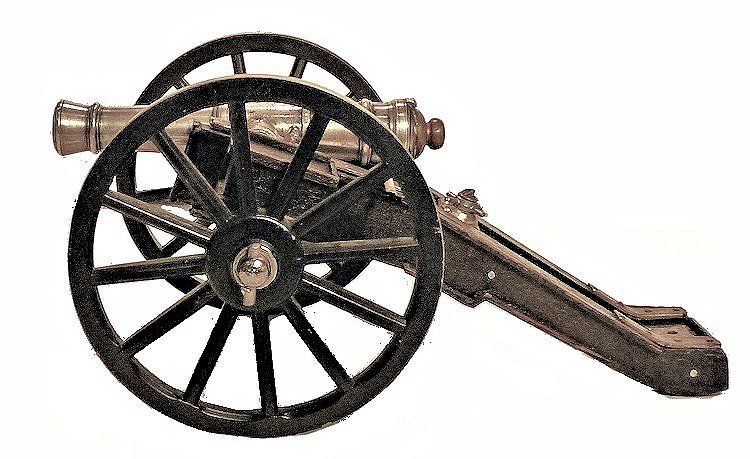Presented
is a seemingly one-of-a-kind Sterling Silver miniature English field artillery breech loading field cannon
Ca 1854 with presenation engraving. When received, it was fitted to a ship style wood carriage having some age,
but which does not belong to a tube with an Army affiliation as shown below. Consequently, we substituted a contemporary
field style carriage from our collection which is almost the correct scale. The choice of carriage will be left to the
buyer with the field carriage being slightly more.
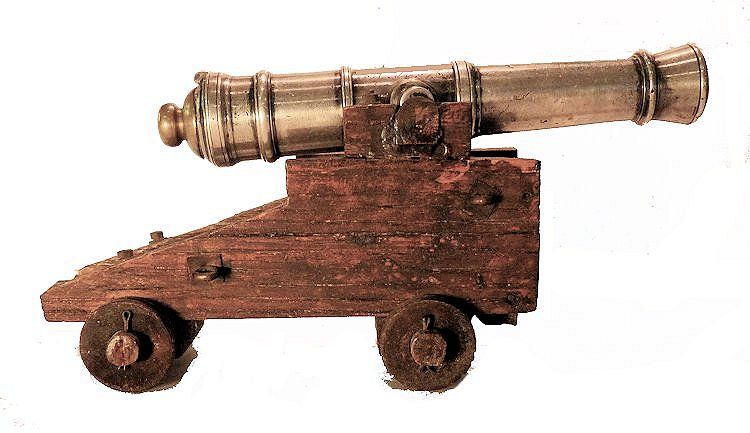
The barrel
weighs 85 grams, and measures 4 1/2″ long, with its widest point being .67″ in diameter. The brass breech is
removeable and does not have a locking mechanism so that this gun cannot be safely fired. Though there are no assayer marks,
the tube has been tested and found to be of sterling silver.
Along
the top of the barrel, between the second and third reinforcing rings, it is engraved: “Presented to Serj’ J. Bennett by Capt.
P.J. Campbell” on three lines and the acronym, “R.H.A” underneath, standing for Royal Horse Artillery.
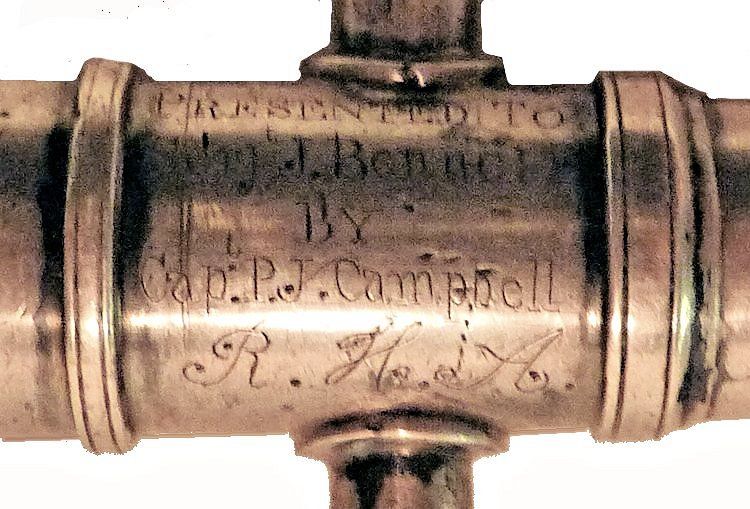
The
6-pound field gun was a lightweight, mobile piece that dates back as far as 1793 and was always a favored field weapon
by artillerymen worldwide as shown below.
This fine old
silver relic cannot be safely fired. Please don’t try.
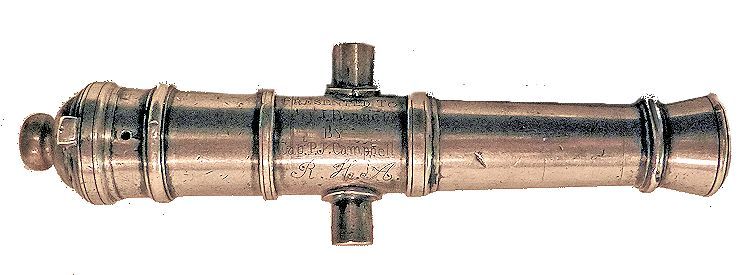
FIELD
CARRIAGE DIMENSIONS:
Cannon Length overall 8″ Weight 2
pounds
Length barrel 4
1/2″ Bore 10.8 mm or .425 inches
Maximum Width 4 1/4″
Carriage 4 1/4″ W x 7 1/2″ L x 3 3/4″ Diameter wheels
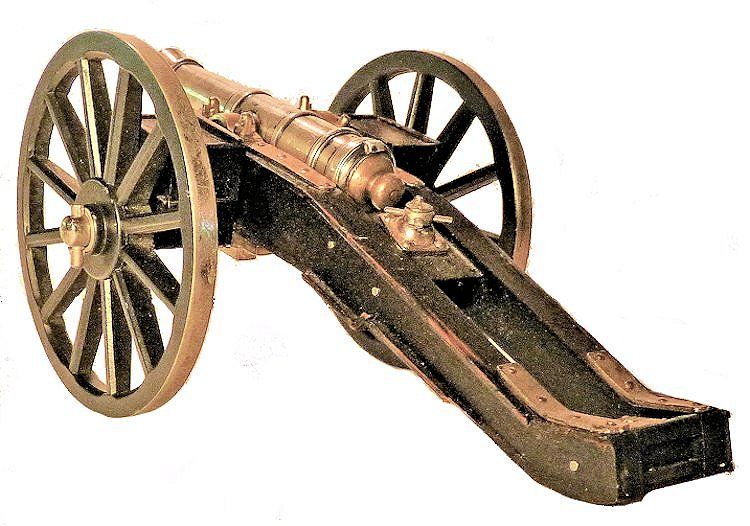

FIELD
CARRIAGE CONDITION: The professionally made contemporary wood carriage is in good condition
and its pot metal fittings are accurate for the period as can be seen in the picture of the real British
6 Pounder shown above. The wheels are of cast brass. There are no foundry marks or inscriptions on the carriage.
There is no method to adjust elevation except by using a small piece of wood such as a tooth pick.

SHIP’S
STYLE CARRIAGE: The picture below shows the carriage that came with the sterling silver barrel.
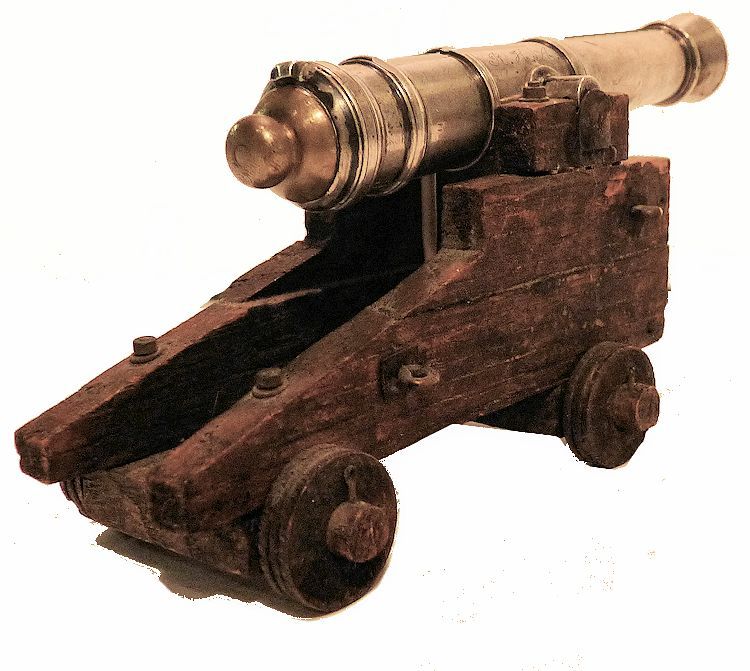
PROVENANCE:
This cannon as mounted on the ship’s type carriage was
said to come from the estate of a man who collected miniature cannons in South Jersey. Even though it was incorrectlly mounted,
it was considered the best of his collection which is quite strange since most collectors are expert in their field of interest.
Maybe the collector was referring only to the barrel which certainly could be worthy of that description.
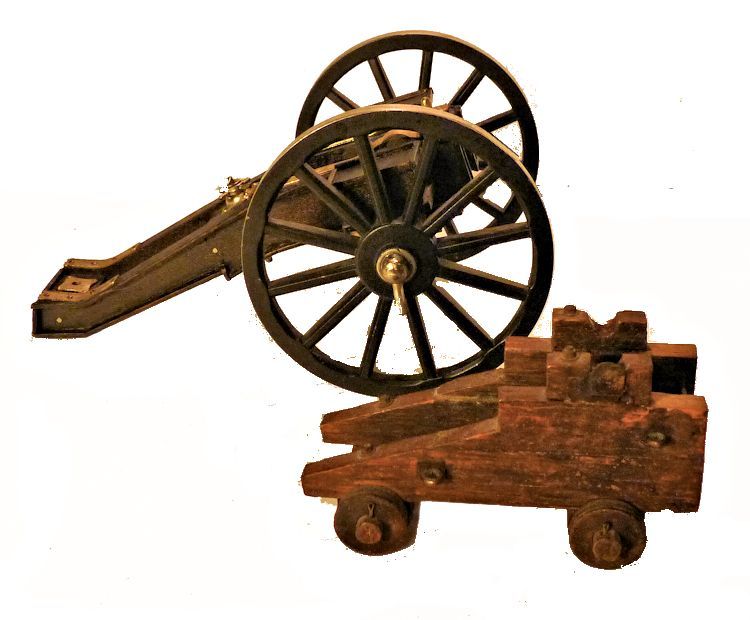
BIOGRAPHY
OF THE PRESENTING OFFICER:
“COLONEL PATRICK JOHN CAMPBELL, R.H.A., joined the Royal Artillery in October, 1847; proceeded soon afterwards
to the Cape of Good Hope, served a year in Natal, and then joined the army in Kaffraria soon after the outbreak of the Kaffir
war of 1851-2-3; was employed in numerous engagements and skirmishes, including the attack on Meromo’s stronghold, when
the 74th Regiment suffered so severely, losing their Colonel (Fordyce) and three officers killed, and many officers and men
wounded.
On his commanding officer, Major Eardley Wilmot, being killed in action, he succeeded to the command of the Royal Artillery
in the King Williams town Division ; was frequently mentioned in dispatches, and was slightly wounded ; at the conclusion
of the war returned to England ; was appointed to Royal Horse Artillery, joined Chestnut Troop at Canterbury ; promoted to
Captain in 1854.
Went to Crimea as Adjutant to Colonel Maclean, March 9, 1855 ; was present in the trenches in both attacks on Redan
in June and September. Appointed Captain Royal Horse Artillery, and joined H Troop in Dublin. On the outbreak of Indian Mutiny,
accompanied the troop commanded by Colonel J. Turner, to India, but the troop was landed at Madras, and took no part in the
suppression of the Mutiny. Served afterwards at Corfu, Chatham, Shorncliffe, and Aldershot ; again re-appointed to Royal Horse
Artillery, and commanded Battery at Umballa and Peshawur. Promoted to Lt.-Colonel, October, 1871 ; soon re-appointed to Royal
Horse Artillery, and commanded Royal Horse Artillery at Meerut, Rawal Pindee ; succeeded to the command of A Brigade at Head
Quarters, and three Batteries in 1875. Promoted regimental Colonel, March, 1880. Medals, Cape; Crimea, with Clasp; Turkish.
Serving in Royal Horse Artillery 1881.”
THE
ROYAL HORSE ARTILLERY:
Active
1 February 1793-present
United
Kingdom, Branch British
Army, Horse Artillery
Almost
all the batteries of the Royal Horse Artillery have served continuously since the French Revolutionary Wars or Napoleonic
Wars, except the King’s Troop which has existed since 1946 and M Battery which was ‘reanimated’ in 1993.
History
of the Royal Horse Artillery
In
1793, in the course of the French Revolutionary Wars, Great Britain and allied European powers declared war on France over
French occupation of the Rhine delta and Antwerp, precipitating the Flanders Campaign. Britain remained in conflict with France
for almost 22 years, during which time significant progress was achieved in artillery development.[2]:p 24 The first two troops
of Horse Artillery (A –later entitled “The Chestnut Troop”– and B) were raised in January 1793 at Goodwood,
East Sussex, by the Master-General of the Ordnance, the 3rd Duke of Richmond, to provide fire support for the cavalry. They
were joined by two more troops in November 1793. Each troop had six 6-pounder guns. All RHA personnel were mounted. Included
in the establishment were 45 drivers and 187 horses, making it the first self-contained fighting unit of artillery.
Captain
John Macleod was the first brigade major and became the first deputy-adjutant-general in 1795. By 1806, eleven troops had
been formed, with ten companies of the Royal Irish Artillery incorporated, as the Seventh Battalion, after the union with
Ireland in 1801
The
RHA has acquitted itself with distinction in the great wars of two centuries, the Napoleonic Wars, the Indian Mutiny, the
Crimean War, the Peninsular War, the Anglo-Zulu War, the Boer War, World War I and World War II. From Wikipedia,
the free encyclopedia
|
